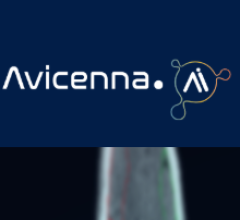
Workflow of radiomics analysis for IHC indicators. Yellow lines denote area of analysis; red lines denote ROI for radiomic features extraction. X = original image, L = low-pass filter, H = high-pass filter. Image courtesy of Jiabing Gu, et al.
September 3, 2019 — Researchers have validated a first-of-its-kind machine learning–based model to evaluate immunohistochemical (IHC) characteristics in patients with suspected thyroid nodules, according to an ahead-of-print article published in the December issue of the American Journal of Roentgenology (AJR).1 The research team achieved “excellent performance” for individualized noninvasive prediction of the presence of cytokeratin 19, galectin 3 and thyroperoxidase based upon computed tomography (CT) images.
“When IHC information is hidden on CT images,” principal investigator Jiabing Gu explained, “it may be possible to discern the relation between this information and radiomics by use of texture analysis.”
To assess whether texture analysis could be utilized to predict IHC characteristics of suspected thyroid nodules, Gu and colleagues from China’s University of Jinan enrolled 103 patients (training cohort–to-validation cohort ratio, ≈ 3:1) with suspected thyroid nodules who had undergone thyroidectomy and IHC analysis from January 2013 to January 2016. All 103 patients — 28 men, 75 women; median age, 58 years; age range, 33–70 years — underwent CT before surgery, and 3D Slicer v 4.8.1 was used to analyze images of the surgical specimen.
To facilitate test-retest methods, 20 patients were imaged in two sets of CT series within 10–15 minutes, using the same scanner (LightSpeed 16, Philips Healthcare) and protocols, without contrast administration. These images were used only to select reproducible and nonredundant features, not to establish or verify the radiomic model.
The Kruskal-Wallis test (SPSS v 19, IBM) was employed to improve classification performance between texture feature and IHC characteristic. Gu et al. considered characteristics with p < 0.05 significant, and the feature-based model was trained via support vector machine methods, assessed with respect to accuracy, sensitivity, specificity, corresponding AUC and independent validation. From 828 total features, 86 reproducible and nonredundant features were selected to build the model.
The best performance of the cytokeratin 19 radiomic model yielded accuracy of 84.4 percent in the training cohort and 80 percent in the validation cohort. Meanwhile, the thyroperoxidase and galectin 3 predictive models evidenced accuracies of 81.4 percent and 82.5 percent in the training cohort, and 84.2 percent and 85 percent in the validation cohort, respectively.
Noting that cytokeratin 19 and galectin 3 levels are high in papillary carcinoma, Gu maintained that these models can help radiologists and oncologists to identify papillary thyroid cancers, “which is beneficial for diagnosing papillary thyroid cancers earlier and choosing treatment options in a timely manner.”
Ultimately, asserted Gu, “this model may be used to identify benign and malignant thyroid nodules.”
For more information: www.ajronline.org
Reference
1. Gu J., Zhu J., Qiu Q., et al. Prediction of Immunohistochemistry of Suspected Thyroid Nodules by Use of Machine Learning–Based Radiomics. American Journal of Roentgenology, published online Aug. 28, 2019. DOI: 10.2214/AJR.19.21535


 November 25, 2025
November 25, 2025 








